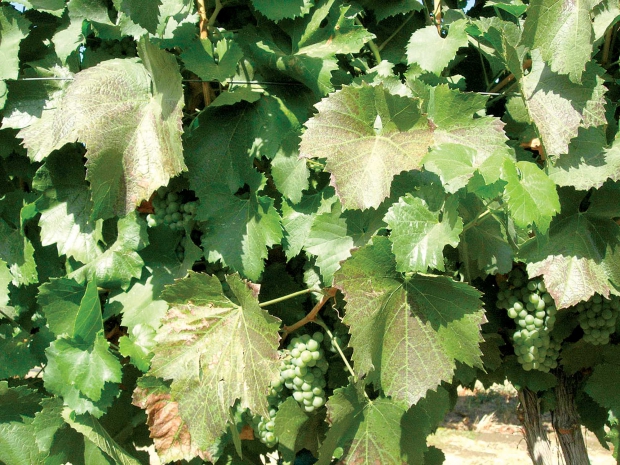What Do Mites Feed on in Vineyards

Bronzing of grape leaves is a classic sign of spider mites. (Courtesy Washington State University)
New research on spider mites did not find resistance to commonly used miticides in Washington State vineyards, but growers should not be lulled into thinking resistance won't develop.
Spider mites are one of the largest and most destructive groups of pests in agriculture. They are commonly found in wine grape vineyards, though are not typical in juice grapes.
Of the five species most often found in wine grapes in the United States—Pacific, McDaniel, European red, two-spotted, and Willamette—the two-spotted spider mite, Tetranychus urticae, is the most common in eastern Washington wine grape vineyards.
Washington State University graduate student Tara Piraneo studied spider mite control and resistance as part of her master's thesis, working with hops and wine grapes.
"Generally, spider mites are considered a secondary pest, and it's only when a disturbance to the environment occurs that we get concerned with populations," she said. "But when mites reach high populations, they can do real economic damage."
In sharing her research with grape growers during the annual meeting of the Washington State Grape Society, Piraneo said that spider mites tend to be more serious in hot, dry years. Dust, cultivation practices, nitrogen application, and pesticides used to control other pests can all enhance spider mite populations.
"Last year, with its warm temperatures and dry conditions, was a good year to study spider mites," said Piraneo, noting that spider mite populations are generally low in Washington vineyards but occasionally flare up.
But with a short life cycle, spider mite populations can build rapidly. The spider mite life cycle is seven to eight days, and there can be multiple generations in a season. "After the crop is harvested, spider mites can overwinter as fertilized females or eggs and become a problem in the next season," she said.
Detection
Piraneo said it's important to scout and monitor vineyards so that mites can be detected early in the season before populations increase. Spider mites are small and difficult to see, but they are visible to the naked eye. A 10x lens can help with detection.
"Usually we find them on the underside of the leaf, residing along the leaf veins, especially the middle rib," she said. Often, you can see crawlers moving about.
Other signs of spider mites are their webbing (which is why they're called spider mites) and cast skins from previous molts.
Feeding by high populations of spider mites can cause speckling of leaves.
"When populations are really high, you'll see yellowing and bronzing of leaves," she said, adding that leaves will begin to die due to the feeding behavior of mites. "Their piercing and sucking mouth parts suck out the cell contents."
Severe infestations affect fruit quality by delaying fruit maturity and ripening due to a reduction of sugars.
Natural enemies
Spider mite integrated pest management strategies include biological control, using natural enemies like predatory mites and lacewing and ladybird beetle larva, cultural practices that minimize dust and manage vineyard floor vegetation, and chemical control that uses targeted sprays.
When using chemical control, there is always the problem of spider mites developing resistance from repeated exposure to the same chemical. "Two-spotted spider mites are one of the most resistant pests in the world and are resistant to more than 90 insecticides," she said.
Piraneo believes that further understanding of mite resistance and toxicity could help improve mite management strategies.
Resistance
In studying resistance, she evaluated abamectin (Agri-Mek) and bifenazate (Acramite), common miticides used in Washington wine grapes. During 2013, Piraneo collected spider mite samples from leaves of 4 vineyards and 13 hop yards.
Female spider mites were brought into the laboratory, transferred to leaf discs placed in petri dishes, and sprayed with labeled rates of the two products. She measured toxicity by determining the percent of mortality within 24 hours of exposure and also determined LC 50 values, the lethal concentration that kills 50 percent of the population.
In hops, mortality rates to abamectin ranged from 100 percent mortality to 50 percent, indicating that some spider mite populations have developed resistance. For bifenazate, the lowest mortality was 76 percent.
"Wine grapes did much better than hops, probably because miticides haven't been used as much as in hops," she said, noting that miticides had not been used in the sampled vineyards in the past year. Mite populations from two of the sampled vineyards died in the petri dish before she exposed them to pesticides. The two remaining vineyard samples had 98 and 95 percent mortality.
"The spider mite populations in the wine grapes were relatively susceptible to the pesticides," Piraneo said.
She also studied spider mite populations in the lab to learn if they were capable of developing tolerance to the chemical within the same season. She found that in hops, two-spotted spider mite developed the largest increase in tolerance to abamectin, with the LC 50s increasing up to 107-fold after ten weekly sprays. A 14-fold increase
in tolerance was observed with bifenazate. Spider mites developed tolerance by the tenth week of application of the same insecticide, but once sprays were stopped, tolerance decreased significantly.
In grapes, two-spotted spider mite developed tolerance to bifenazate, though not at the same rate as in hops. "High tolerances in spider mites on grapes have not been detected, but the pest has the capability to increase tolerance," she stated.
She advises growers to monitor grapes frequently during the season, scouting for mites. "If you detect them early, you usually have time to react using control tactics," Piraneo said, adding that knowing what is present will lead to better management strategies.
"But be aware that if you repeatedly use the same chemical for control, it can lead to resistance." •
One Comment
Source: https://www.goodfruit.com/the-latest-on-dealing-with-spider-mites-in-vineyards/

Good way of describing, and nice piece of writing to get information about my presentation focus, which i am going to convey in institution of higher education.